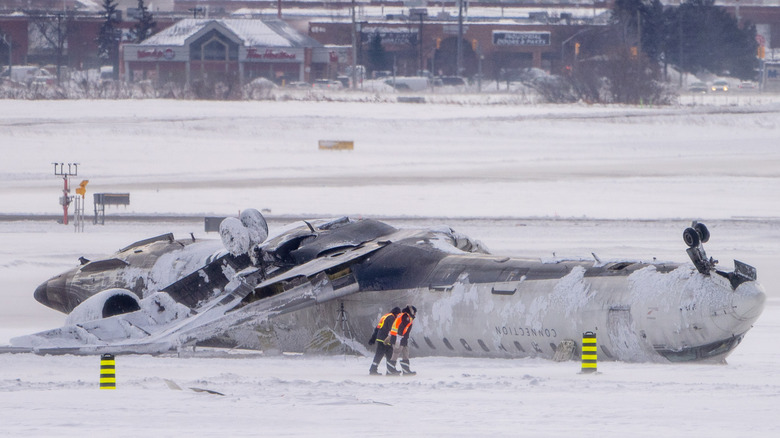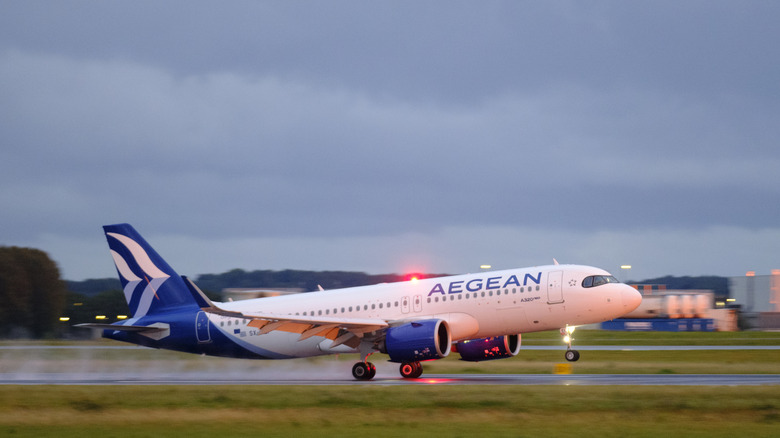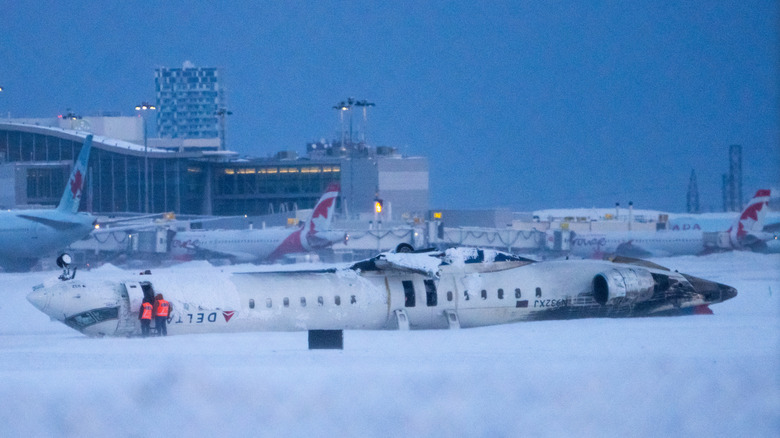What Does It Mean To Flare An Aircraft? (And How Is It Relevant To The Delta Crash?)
Questions abound as investigators try to determine why Delta Airlines flight 4819 crashed as it attempted to land at Toronto Pearson International Airport on Monday afternoon. In a video that has since gone viral, the Bombardier CRJ-900 forcefully landed on the snow-covered runway before bursting into flames and flipping onto its roof — losing both its right wing and tail in the process. The dramatic accident, which injured 21 people, is another in a string of high-profile aviation disasters grabbing headlines this month, fueling speculation over the safety of airplane travel.
To determine the cause of the crash, the Transportation Safety Board of Canada, with assistance from the U.S. National Transportation Safety Board, will investigate a variety of factors, ranging from weather conditions to technical issues. Some experts have speculated, based on the video, that the aircraft's rough landing may have occurred because it did not properly flare as it landed on the runway. The investigation is still ongoing, and although the grainy video is not definitive evidence that the Delta flight failed to flare, it's useful to look at the practice of flaring as a means of better understanding a plane's safety measures.
What does flaring mean?
Have you ever looked out the window of your flight as it screamed towards the runway and thought, "How on earth is the pilot going to slow down enough to land this?" Well, that is where flaring comes in. The landing flare is simply the phase of the landing where the plane transitions from its final approach to touchdown and deceleration on the runway.
It requires the pilot to adjust the pitch of the aircraft, i.e., the angle by which it will hit the runway, and reduce the engine power, thus decreasing the airspeed and descent rate enough to make a soft touchdown. This is one of the more difficult maneuvers of a flight for pilots and takes years of training to master. However, when done correctly, it manages to reduce the aircraft's airspeed enough to produce a smooth landing.
So, how does flaring work exactly? Like all aspects of an aircraft's landing, it begins with a stable approach. Without appropriate airspeed, a clear flight path, and the proper rate of descent, a safe landing is unlikely. The goal of the pilot is to reach the aim point — usually a specific marker on the runway — at the proper speed. Having reached the aim point, the pilot now eases the plane's nose up and reduces engine thrust. In doing so, the pilot gradually reduces the momentum of the aircraft enough to afford an easy touchdown and stop on the designated stretch of runway.
The investigation continues
According to Boeing's statistical analysis, despite constituting less than 1% of the flight's total airtime, most civil aviation accidents occur during a plane's landing. Flaring, in particular, is a notoriously difficult stretch of a landing phase, despite lasting only a matter of seconds. This is due, in large part, to the high number of variables determining success (such as speed and height) and the low altitude in which the procedure occurs. With little space separating a plane from the ground, the pilot must rely largely on visual cues and personal judgment once the plane's wheels hit the runway in order to make split-second decisions.
As it stands, any notion that Delta Airlines flight 4819 failed to flare is highly speculative. While some experts theorize that a properly executed flare could have prevented the crash, it is just as true that poor runway and weather conditions or technical failures with the landing gear or another component could have been responsible for the near-disastrous accident. In either case, it may be some time before investigators come to any conclusion.
As Delta CEO Ed Bastian said in an interview with CBS on Wednesday, "We've all seen the videos, that's about as much detail as we can look at and talk about at this moment." According to Bastian, the crew that operated the Endeavor Air (a subsidiary of Delta) flight from Minneapolis was an experienced one that "performed heroically, but also as expected. This is what we train for." Luckily, as of the writing of this piece, twenty of the twenty-one injured have left the hospital.


